101 books about Microeconomics and 5
start with D
101 books about Microeconomics and 5
101 books about Microeconomics
5 start with D start with D
5 start with D start with D
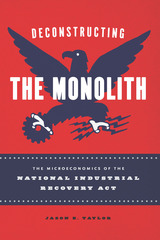
Deconstructing the Monolith
The Microeconomics of the National Industrial Recovery Act
Jason E. Taylor
University of Chicago Press, 2019
The National Industrial Recovery Act (NIRA) was enacted by Congress in June of 1933 to assist the nation’s recovery during the Great Depression. Its passage ushered in a unique experiment in US economic history: under the NIRA, the federal government explicitly supported, and in some cases enforced, alliances within industries. Antitrust laws were suspended, and companies were required to agree upon industry-level “codes of fair competition” that regulated wages and hours and could implement anti-competitive provisions such as those fixing prices, establishing production quotas, and imposing restrictions on new productive capacity.
The NIRA is generally viewed as a monolithic program, its dramatic and sweeping effects best measurable through a macroeconomic lens. In this pioneering book, however, Jason E. Taylor examines the act instead using microeconomic tools, probing the uneven implementation of the act’s codes and the radical heterogeneity of its impact across industries and time. Deconstructing the Monolith employs a mixture of archival and empirical research to enrich our understanding of how the program affected the behavior and well-being of workers and firms during the two years NIRA existed as well as in the period immediately following its demise.
The NIRA is generally viewed as a monolithic program, its dramatic and sweeping effects best measurable through a macroeconomic lens. In this pioneering book, however, Jason E. Taylor examines the act instead using microeconomic tools, probing the uneven implementation of the act’s codes and the radical heterogeneity of its impact across industries and time. Deconstructing the Monolith employs a mixture of archival and empirical research to enrich our understanding of how the program affected the behavior and well-being of workers and firms during the two years NIRA existed as well as in the period immediately following its demise.
[more]
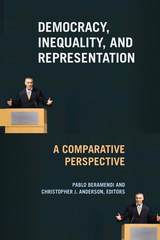
Democracy, Inequality, and Representation in Comparative Perspective
Pablo Beramendi
Russell Sage Foundation, 2008
The gap between the richest and poorest Americans has grown steadily over the last thirty years, and economic inequality is on the rise in many other industrialized democracies as well. But the magnitude and pace of the increase differs dramatically across nations. A country's political system and its institutions play a critical role in determining levels of inequality in a society. Democracy, Inequality, and Representation argues that the reverse is also true—inequality itself shapes political systems and institutions in powerful and often overlooked ways. In Democracy, Inequality, and Representation, distinguished political scientists and economists use a set of international databases to examine the political causes and consequences of income inequality. The volume opens with an examination of how differing systems of political representation contribute to cross-national variations in levels of inequality. Torben Iverson and David Soskice calculate that taxes and income transfers help reduce the poverty rate in Sweden by over 80 percent, while the comparable figure for the United States is only 13 percent. Noting that traditional economic models fail to account for this striking discrepancy, the authors show how variations in electoral systems lead to very different outcomes. But political causes of disparity are only one part of the equation. The contributors also examine how inequality shapes the democratic process. Pablo Beramendi and Christopher Anderson show how disparity mutes political voices: at the individual level, citizens with the lowest incomes are the least likely to vote, while high levels of inequality in a society result in diminished electoral participation overall. Thomas Cusack, Iverson, and Philipp Rehm demonstrate that uncertainty in the economy changes voters' attitudes; the mere risk of losing one's job generates increased popular demand for income support policies almost as much as actual unemployment does. Ronald Rogowski and Duncan McRae illustrate how changes in levels of inequality can drive reforms in political institutions themselves. Increased demand for female labor participation during World War II led to greater equality between men and women, which in turn encouraged many European countries to extend voting rights to women for the first time. The contributors to this important new volume skillfully disentangle a series of complex relationships between economics and politics to show how inequality both shapes and is shaped by policy. Democracy, Inequality, and Representation provides deeply nuanced insight into why some democracies are able to curtail inequality—while others continue to witness a division that grows ever deeper.
[more]
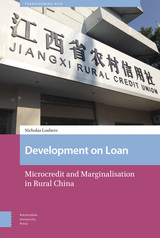
Development on Loan
Microcredit and Marginalisation in Rural China
Nicholas Loubere
Amsterdam University Press, 2019
Key to China's plans to promote rural development is the de-marginalisation of the countryside through the incorporation of rural areas into the urban-based market-oriented financial system. For this reason, Chinese development planners have turned to microcredit -- i.e. the provision of small-scale loans to 'financially excluded' rural households -- as a means of increasing 'financial consciousness' and facilitating rural de-marginalisation. Drawing on in-depth fieldwork in rural China, this book examines the formulation, implementation and outcomes of government-run microcredit programmes in China, illuminating the diverse roles that microcredit plays in local processes of socioeconomic development and the livelihoods of local actors. It details how microcredit facilitates de-marginalisation for some, while simultaneously exacerbating the marginalisation of others; and exposes the ways in which microcredit and other top-down development strategies reflect and reinforce the contradictions and paradoxes implicit in rural China's contemporary development landscape.
[more]
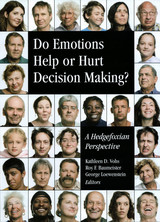
Do Emotions Help or Hurt Decisionmaking?
A Hedgefoxian Perspective
Kathleen D. Vohs
Russell Sage Foundation, 2007
Philosophers have long tussled over whether moral judgments are the products of logical reasoning or simply emotional reactions. From Jane Austen's Sense and Sensibility to the debates of modern psychologists, the question of whether feeling or sober rationality is the better guide to decision making has been a source of controversy. In Do Emotions Help or Hurt Decision Making? Kathleen Vohs, Roy Baumeister, and George Loewenstein lead a group of prominent psychologists and economists in exploring the empirical evidence on how emotions shape judgments and choices. Researchers on emotion and cognition have staked out many extreme positions: viewing emotions as either the driving force behind cognition or its side effect, either an impediment to sound judgment or a guide to wise decisions. The contributors to Do Emotions Help or Hurt Decision Making? provide a richer perspective, exploring the circumstances that shape whether emotions play a harmful or helpful role in decisions. Roy Baumeister, C. Nathan DeWall, and Liqing Zhang show that while an individual's current emotional state can lead to hasty decisions and self-destructive behavior, anticipating future emotional outcomes can be a helpful guide to making sensible decisions. Eduardo Andrade and Joel Cohen find that a positive mood can negatively affect people's willingness to act altruistically. Happy people, when made aware of risks associated with altruistic acts, become wary of jeopardizing their own well-being. Benoît Monin, David Pizarro, and Jennifer Beer find that whether emotion or reason matters more in moral evaluation depends on the specific issue in question. Individual characteristics often mediate the effect of emotions on decisions. Catherine Rawn, Nicole Mead, Peter Kerkhof, and Kathleen Vohs find that whether an individual makes a decision based on emotion depends both on the type of decision in question and the individual's level of self-esteem. And Quinn Kennedy and Mara Mather show that the elderly are better able to regulate their emotions, having learned from experience to anticipate the emotional consequences of their behavior. Do Emotions Help or Hurt Decision Making? represents a significant advance toward a comprehensive theory of emotions and cognition that accounts for the nuances of the mental processes involved. This landmark book will be a stimulus to scholarly debates as well as an informative guide to everyday decisions.
[more]
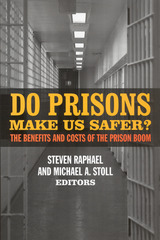
Do Prisons Make Us Safer?
The Benefits and Costs of the Prison Boom
Steven Raphael
Russell Sage Foundation, 2009
The number of people incarcerated in U.S. prisons and jails more than quadrupled between 1975 and 2005, reaching the unprecedented level of over two million inmates today. Annual corrections spending now exceeds 64 billion dollars, and many of the social and economic burdens resulting from mass incarceration fall disproportionately on minority communities. Yet crime rates across the country have also dropped considerably during this time period. In Do Prisons Make Us Safer? leading experts systematically examine the complex repercussions of the massive surge in our nation's prison system. Do Prisons Make Us Safer? asks whether it makes sense to maintain such a large and costly prison system. The contributors expand the scope of previous analyses to include a number of underexplored dimensions, such as the fiscal impact on states, effects on children, and employment prospects for former inmates. Steven Raphael and Michael Stoll assess the reasons behind the explosion in incarceration rates and find that criminal behavior itself accounts for only a small fraction of the prison boom. Eighty-five percent of the trend can be attributed to "get tough on crime" policies that have increased both the likelihood of a prison sentence and the length of time served. Shawn Bushway shows that while prison time effectively deters and incapacitates criminals in the short term, long-term benefits such as overall crime reduction or individual rehabilitation are less clear cut. Amy Lerman conducts a novel investigation into the effects of imprisonment on criminal psychology and uncovers striking evidence that placement in a high security penitentiary leads to increased rates of violence and anger—particularly in the case of first time or minor offenders. Rucker Johnson documents the spill-over effects of parental incarceration—children who have had a parent serve prison time exhibit more behavioral problems than their peers. Policies to enhance the well-being of these children are essential to breaking a devastating cycle of poverty, unemployment, and crime. John Donohue's economic calculations suggest that alternative social welfare policies such as education and employment programs for at-risk youth may lower crime just as effectively as prisons, but at a much lower human cost. The cost of hiring a new teacher is roughly equal to the cost of incarcerating an additional inmate. The United States currently imprisons a greater proportion of its citizens than any other nation in the world. Until now, however, we've lacked systematic and comprehensive data on how this prison boom has affected families, communities, and our nation as a whole. Do Prisons Make Us Safer? provides a highly nuanced and deeply engaging account of one of the most dramatic policy developments in recent U.S. history.
[more]
READERS
Browse our collection.
PUBLISHERS
See BiblioVault's publisher services.
STUDENT SERVICES
Files for college accessibility offices.
UChicago Accessibility Resources
home | accessibility | search | about | contact us
BiblioVault ® 2001 - 2024
The University of Chicago Press









